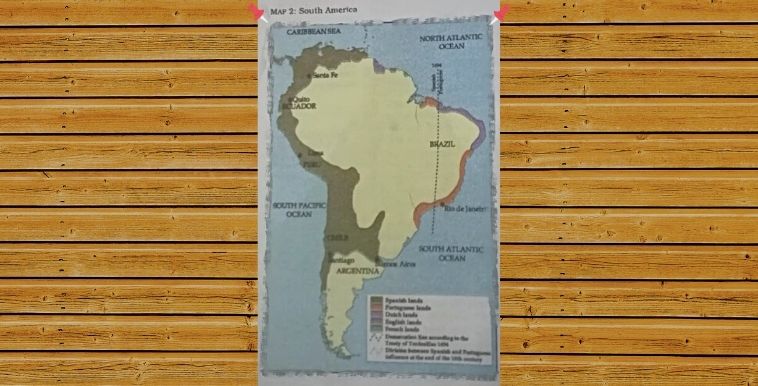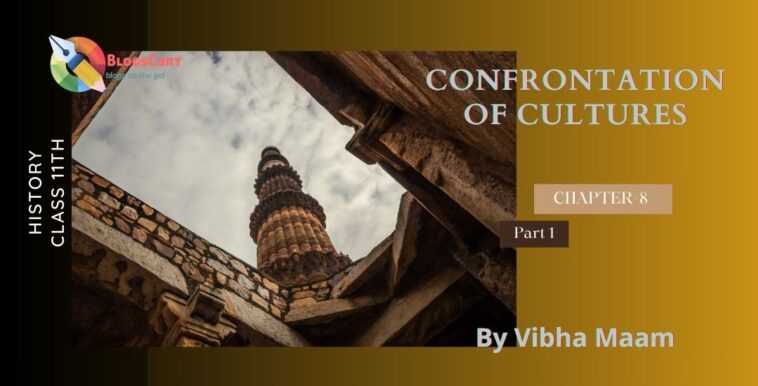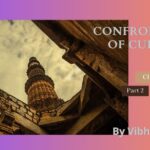This post is the precise notes of class 11 History chapter 8 notes.
Confrontation Of Cultures Part-1 by Vibha Maam
Europeans and Americans between 15th to 17th centuries
- In the 15th century, the Spanish and the Portuguese came to find trading routes of spices and silver.
- Christopher Columbus (An Italian) sailed west in 1492 and explored a new world of Americas. That was not the part of Asia.
- There were two types of culture in America:- Aztecs and Maya of Central America and the Incas of Peru.
- There were powerful monarchical systems based on well developed agriculture, mining and had monumental architecture.
- The exploration and settlement of South America were to have disastrous consequences for the native people and their cultures.
- It also marked the beginning of the slave trade.
- Europeans selling slaves from Africa to work in plantations and mines in America.
- Europeans conquered the people of America and destroyed their manuscripts and monuments.
- The Inka city of Machu Picchu was discovered in 1911.
- South America was densely forested and mountainous, and the Amazon, the world’s largest river, flows through miles of dense forest.
In Mexico, in Central America there were settled areas of habitation along the coast and in plains, while elsewhere villages were scattered over forested areas.
Communities of the Caribbean and Brazil
Arawak’s lived on small Islands in Caribbean sea (Bahamas) and the Greater Antilles
- Arawak’s were skilled boat-builders, canoe sailors.
- They lived by hunting, fishing and agriculture.
- They were growing corn, sweet potatoes, tubers, and cassava.
- They were organised under clan elders.
- Polygamy was common.
- The Arawak’s were animists.
- The Arawak’s used gold for ornaments.
- They were good at weaving and the hammock was one of their specialties.
- The Arawak’s were generous and happy to collaborate with the Spanish ,but this was to have disastrous consequences for them.
Tupinamba lived on the east coast of South America (Brazil)
- The name’ Brazil’ is derived from the Brazilwood tree.
- They had no access to iron.
- They did not depend on agriculture because they had plentiful supply of fruits, vegetables and fish.
- There were no king, no army or no Church to regulate their lives. They enjoyed happy freedom.

The state systems of Central and South America
Besides the Caribbean and Brazil, there were some highly organised states in Central America. Aztecs, Mayas and Incas had urbanized civilization and monumental architecture.
The Aztecs
The Aztecs had migrated from the north into the central valley of Mexico.
- The Aztec society was hierarchical.
- The hereditary nobility occupied the senior position in the government, army and priesthood.
- The king was regarded as the representative of the sun on earth. The king was chosen by nobles from amongst them.
- Warriors, priests, nobles, artisans, physicians and teachers were the most respected group.
- Traders served the government as ambassador and spies and also enjoyed many privileges.
- The Aztecs made artificial Islands (chinampas) in Mexico lake.
- Canals were constructed on these fertile islands.
- In 1325, the capital city ‘Tenochtitlan’ was constructed on this island.
- Its palaces and pyramids rose dramatically out of the lake
- The temples were dedicated to the gods of war and the sun.
- Land was owned by clans which also organised public construction works. people cultivated corn, beans, pumpkins, manioc, potatoes and other crops.
- Peasants cultivated nobles’ land for some part of the harvest.
- The poor sometimes would sell their children only for a limited period.
- The Aztecs made sure that all children went to school; children of nobility attended the ‘Calmecac’ and all others went to the “Tepochcalli”.
- Boys received military training as well as training in agriculture and trades whereas girls were trained in domestic skills.
In the early 16 century the Aztec Empire began to slide into instability.
The Mayas
The Mayan culture of Mexico developed between the 11th and 14th centuries.
- They had less political power than Aztecs .
- Corn cultivation was Central to their culture and many religious festivals.
- The ruling classes, priests and chiefs were prosperous due to a generous surplus of corn. This helped them to invest in the development of architecture, astronomy and mathematics.
- The Mayas devised a pictographic form of writing which has only been partially deciphered.
The Incas of Peru
The largest of the indigenous civilization in South America was the incas in Peru (quechuas)
- In the 12th century the first Inca, Manco Capac, established his capital at Cuzco.
- The Inca Empire stretched 3000 miles from Ecuador to Chile.
- Quechua was the court language of Incas.
Similarities between Inca Empire and Aztec Empire
- The Empire was highly centralised. The king was the highest authority in the empire.
- Like the Aztec empire, the Inka Empire resembled a confederacy.
- Like the Aztec, the Incas too were magnificent builders.
- They built roads through mountains from Ecuador to Chile.
- They built forts and large temples.
- They did not have any wheeled vehicles to transport heavy stones.
- They used labour-intensive technology to carve and move stones.
- Masons shaped the blocks by using a simple and effective method called flaking.
- The basis of the Inca civilization was agriculture.
- They developed a system of drainage and irrigation.
The Incas grew corn and potatoes and reared llamas for food and labour .
They were experts in weaving and pottery.
They did not develop a system of writing. They used ‘quipu’ or cords upon which knots were made to indicate specific mathematical units.

Differences between Incas’ and European culture
The culture of Incas and Aztecs were almost common but very different from European culture.
- The Inca society was hierarchical but there was no private ownership of resources by a few people as in Europe.
- The priests and shamans were accorded an honour status.
- Gold was used ritually in temples; there was no great value placed on gold or silver. This was also in marked contrast to contemporary European society.
Share this note with your friends and classmates and also comment in the comment section below.
For Novels and books at affordable price you can checkout Checkfirst








[…] NCERT Class 11th History chapter 8 Confrontation Of Cultures Part 1 Notes by Vibha Maam CBSE | Engli… […]
great job
I loved as much as youll receive carried out right here The sketch is attractive your authored material stylish nonetheless you command get bought an nervousness over that you wish be delivering the following unwell unquestionably come more formerly again as exactly the same nearly a lot often inside case you shield this hike
Attractive section of content. I just stumbled upon your blog and in accession capital to assert that I get actually enjoyed account your blog posts. Anyway I will be subscribing to your augment and even I achievement you access consistently fast.